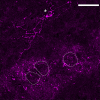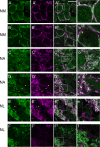Expression and Neurotransmitter Association of the Synaptic Calcium Sensor Synaptotagmin in the Avian Auditory Brain Stem
- PMID: 35999323
- PMCID: PMC9789253
- DOI: 10.1007/s10162-022-00863-1
Expression and Neurotransmitter Association of the Synaptic Calcium Sensor Synaptotagmin in the Avian Auditory Brain Stem
Abstract
In the avian auditory brain stem, acoustic timing and intensity cues are processed in separate, parallel pathways via the two divisions of the cochlear nucleus, nucleus angularis (NA) and nucleus magnocellularis (NM). Differences in excitatory and inhibitory synaptic properties, such as release probability and short-term plasticity, contribute to differential processing of the auditory nerve inputs. We investigated the distribution of synaptotagmin, a putative calcium sensor for exocytosis, via immunohistochemistry and double immunofluorescence in the embryonic and hatchling chick brain stem (Gallus gallus). We found that the two major isoforms, synaptotagmin 1 (Syt1) and synaptotagmin 2 (Syt2), showed differential expression. In the NM, anti-Syt2 label was strong and resembled the endbulb terminals of the auditory nerve inputs, while anti-Syt1 label was weaker and more punctate. In NA, both isoforms were intensely expressed throughout the neuropil. A third isoform, synaptotagmin 7 (Syt7), was largely absent from the cochlear nuclei. In nucleus laminaris (NL, the target nucleus of NM), anti-Syt2 and anti-Syt7 strongly labeled the dendritic lamina. These patterns were established by embryonic day 18 and persisted to postnatal day 7. Double-labeling immunofluorescence showed that Syt1 and Syt2 were associated with vesicular glutamate transporter 2 (VGluT2), but not vesicular GABA transporter (VGAT), suggesting that these Syt isoforms were localized to excitatory, but not inhibitory, terminals. These results suggest that Syt2 is the major calcium binding protein underlying excitatory neurotransmission in the timing pathway comprising NM and NL, while Syt2 and Syt1 regulate excitatory transmission in the parallel intensity pathway via cochlear nucleus NA.
Keywords: Auditory nerve; Avian; Cochlear nucleus; Nucleus angularis; Nucleus magnocellularis; Synaptotagmin; VGAT; VGluT.
© 2022. The Author(s) under exclusive licence to Association for Research in Otolaryngology.
Conflict of interest statement
The authors declare no competing interests.
Figures










Similar articles
-
Tonotopic differentiation of presynaptic neurotransmitter-releasing machinery in the auditory brainstem during the prehearing period and its selective deficits in Fmr1 knockout mice.J Comp Neurol. 2022 Dec;530(18):3248-3269. doi: 10.1002/cne.25406. Epub 2022 Sep 6. J Comp Neurol. 2022. PMID: 36067267 Free PMC article.
-
Synaptotagmin2 (Syt2) Drives Fast Release Redundantly with Syt1 at the Output Synapses of Parvalbumin-Expressing Inhibitory Neurons.J Neurosci. 2017 Apr 26;37(17):4604-4617. doi: 10.1523/JNEUROSCI.3736-16.2017. Epub 2017 Mar 31. J Neurosci. 2017. PMID: 28363983 Free PMC article.
-
Target-specific regulation of presynaptic release properties at auditory nerve terminals in the avian cochlear nucleus.J Neurophysiol. 2016 Mar;115(3):1679-90. doi: 10.1152/jn.00752.2015. Epub 2015 Dec 30. J Neurophysiol. 2016. PMID: 26719087 Free PMC article.
-
Short-term plasticity and auditory processing in the ventral cochlear nucleus of normal and hearing-impaired animals.Hear Res. 2011 Sep;279(1-2):131-9. doi: 10.1016/j.heares.2011.04.018. Epub 2011 May 10. Hear Res. 2011. PMID: 21586317 Free PMC article. Review.
-
Beyond timing in the auditory brainstem: intensity coding in the avian cochlear nucleus angularis.Prog Brain Res. 2007;165:123-33. doi: 10.1016/S0079-6123(06)65008-5. Prog Brain Res. 2007. PMID: 17925243 Free PMC article. Review.
Cited by
-
Cellular and synaptic specializations for sub-millisecond precision in the mammalian auditory brainstem.Front Cell Neurosci. 2025 May 19;19:1568506. doi: 10.3389/fncel.2025.1568506. eCollection 2025. Front Cell Neurosci. 2025. PMID: 40458470 Free PMC article. Review.
-
BDNF Differentially Affects Low- and High-Frequency Neurons in a Primary Nucleus of the Chicken Auditory Brainstem.Biology (Basel). 2024 Oct 29;13(11):877. doi: 10.3390/biology13110877. Biology (Basel). 2024. PMID: 39596832 Free PMC article.
-
Tonotopic differentiation of presynaptic neurotransmitter-releasing machinery in the auditory brainstem during the prehearing period and its selective deficits in Fmr1 knockout mice.J Comp Neurol. 2022 Dec;530(18):3248-3269. doi: 10.1002/cne.25406. Epub 2022 Sep 6. J Comp Neurol. 2022. PMID: 36067267 Free PMC article.
-
A single base pair substitution in zebrafish distinguishes between innate and acute startle behavior regulation.PLoS One. 2024 Mar 18;19(3):e0300529. doi: 10.1371/journal.pone.0300529. eCollection 2024. PLoS One. 2024. PMID: 38498506 Free PMC article.
References
Publication types
MeSH terms
Substances
Grants and funding
LinkOut - more resources
Full Text Sources

